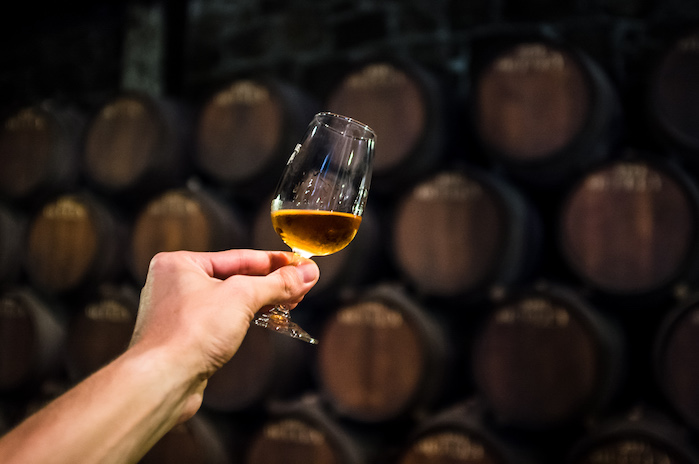That the term “craft” has lost its meaning is nothing new.
For years now the word has come to mean a broad swatch of things. Both the craft spirits and beer movements have expanded into the mainstream, attracting entries from large-scale producers that likely do not quality as “craft.”
Do consumers care? Success of brands like Bulleit Bourbon would suggest: no.
Or is that a matter of a quality entry-level product? And for that matter, what exactly is an actual craft distiller in 2019?
These were questions posed to a panel of industry insiders during Vinexpo 2019. Moderator Jeffery Lindemuth, executive editor of Whisky Advocate, tasked his panelists to define craft spirits.
“It’s difficult to define because ‘craft’ is in the eye of the beholder, and everybody now wants to be whatever ‘craft’ is,” said Paul Hletko, founder and president of Few Spirits, the craft distilling pioneer from Chicago. “I don’t like the word ‘craft’, but I use it because that’s what the customer wants.”
Hletko is also a member and former president of the American Craft Spirits Association (ACSA), which supports and advocates for the community of craft spirits. “We define ourselves as small, independent and creative,” he explained.
The ACSA definition includes qualifiers that the distillery produces fewer than 750,000 gallons annually, and has more than a 75% equity stake in their company and operational control.
Still, Hletko believes that “‘craft’ is overused as far as a word goes, because it doesn’t mean much. Heck, Subway had a ‘craft sandwich’ there for a while.”
Yet there is no getting away from the term “craft,” thanks in large part to its dominance of another category.

“The craft spirits world was stuck with the identifier ‘craft’ by the craft beer world,” explained panelist Brett Pontoni, spirits buyer for Binny’s Beverage Depot, which counts 40 locations in Illinois. “It was very easy to apply the craft term to beer. In the ‘80s and ‘90s, you had all those tiny local places, and now again in the second wave of craft beer.”
Helping broaden the term was the boom of larger-scale craft breweries like New Belgium, Bell’s, Dogfish Head and Ballast Point that have achieved cross-country distribution. “There were already fantastic spirits being mass produced, but not the same for beer,” Pontoni said. “So there was a void that could be filled.”
Monique Huston, national director of spirits for Winebow, is also not a fan of the term, but defined craft as “authentic, transparent, family or estate. That’s what people were missing in spirits before the current craft boom. People didn’t have a sense of a spirit’s place, or what’s going on in the background.”
It’s the consumer’s thirst for education, for knowing where their products came from, that has led to the current trend where every whiskey must have a background story — whether these tales are 100% accurate or not.
Another issue with the word “craft” is that it does not always mean “quality.” Some newer brands and producers, eager to recoup upfront investment costs and/or cash in on the brown spirits boom, will release younger or improperly aged products that do not taste nearly as good as their price tag would suggest.
“We’re seeing a lot of people say they’ve had their local spirits, and now they want what’s good,” Pontoni said.
Huston concurred. “The real difficulty for a lot of these local places is selling that second bottle. I see a lot of local bottles in the close-out aisle.”
Still, Pontoni believes that the microdistillery movement has been a net positive for the overall quality of the category. “I’ve noticed that the floor is coming up in terms of quality,” he said. “I’m still waiting for a massive amount of new producers to hit homeruns, but at least a lot of people are currently hitting singles.”
And getting back to the question of Bulleit Bourbon, which Huston called a “fabricated story with sourced whiskey.”
“At the end of the day, we benefitted greatly from that,” she added. Bulleit’s widespread success was what first interested consumers in “craft” whiskey, whether the brand truly represented that term or not. “If you can’t get people into Diageo whiskey at $22, how can you ever expect to get them to buy craft whiskey at $35?” Huston said.
The importance for retailers, then, is to train staff to help educate consumers.
And many consumers already have a notion of ‘craft’ thanks to their own Googling of the subject and its brands.
“We let our customer tell us what they think craft is,” Pontoni said, “and once they open that door, we can walk in and educate.”
Kyle Swartz is editor of Beverage Dynamics magazine. Reach him at kswartz@epgmediallc.com or on Twitter @kswartzz or Instagram @cheers_magazine. Read his recent piece Interview: Woodford Reserve’s Chris Morris and Elizabeth McCall on Wheat Whiskey, Mint Juleps and More.




